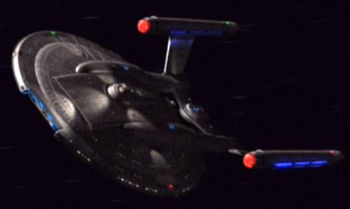NX class

The first of a new generation of Warp 5 starships designed for long-term space travel and scientific discovery, the first NX class starship, Enterprise NX-01, was launched in April 2151 under the command of Captain Jonathan Archer. The NX class was the culmination of more than three decades of research and development at the Warp Five Complex by Archer's father, Dr. Henry Archer, and other scientists inspired by warp pioneer Zefram Cochrane. The NX class's Warp 5 engine put humanity within reach of thousands of inhabited worlds, compared to the small handful at lower warp speeds, for the first time.[2]
The NX class utilized the dual-nacelle design[2] that was first employed by Cochrane's Phoenix.[3] Most of the crew's activities took place in a large saucer section, which contained crew quarters, science departments, a sickbay, cargo bays and an armory. The bridge—the command center of the ship—sat atop the saucer section. The front of the saucer section was equipped with a deflector dish that protected the ship from space dust and other particles that would otherwise cause significant damage at faster-than-light speeds.[2]
The NX class was equipped with up to four shuttlepods in its ventral launch bay; each could accommodate a pilot and up to six passengers. Capable of sub-warp speeds only, the shuttlepods were designed to take groups short distances from the ship, such as to the surface of a planet or to another nearby ship or space station. A shuttlepod launched by dropping down through the "bomb bay" doors on the deck of the launch bay, then once it was safely positioned below the hull, it reoriented itself toward its destination.[2] The shuttlepods were equipped with enough oxygen for two crewmembers to survive more than 10 days.[4]
The NX class was also equipped with a transporter system, designed primarily to "beam" cargo and technology to and from the ship. Prior to launch, the transporter platform was approved for use with biomatter, but the crew was still wary of using it on themselves for many years, preferring instead to travel in the shuttlepods.[2]
When landing parties returned from alien environments where they were at risk of exposure to unusual radiation or microbes, they would receive a bioscan in the decontamination chamber. If the scan detected anything out of the ordinary, the team would strip down to minimal clothing and apply an appropriate decontamination gel to their skin to neutralize any pathogens, while they were bathed in ultraviolet light, which would destroy most known microbial life.[2]
The ship's galley was stocked with genuine foodstuffs, but was also equipped with a protein resequencer, which could replicate a limited menu of basic dishes such as pasta, soup and simple beverages. For the most part, meals were prepared by the ship's galley crew. Aside from the primary mess hall, there was also an adjacent captain's mess, a small, private area where the commanding officer could take meals in private or with guests.[2]
Com panels allowed communication among crew members located in different parts of the ship. Positioned on walls in virtually every section of the vessel, the com panel was activated by tapping a control and addressing the person being contacted. A computer program located the recipient and completed the channel automatically, or opened a ship-wide page if the recipient could not be located.[2]
The NX class relied on polarized hull plating to protect itself against enemy weapons. When the hull plating was down, the ship was vulnerable to attack. For offensive capabilities, the ship was equipped with spatial torpedoes,[2] and later photonic torpedoes,[5] which were launched from the torpedo bays.[2] The NX class also carried phase cannons, a phase-modulated energy weapon rated for a maximum power output of 500 gigajoules. The phase cannons were deployed with retractable turrets that extended from the hull and fired energy beams at their targets.[6]
The NX class was also equipped with a "grappler," which consisted of two large magnets deployed by extremely long tethers, used to latch onto a shuttlepod or a small alien ship for rescue or defensive purposes.[2] Long-range communications with Earth were made possible by a series of subspace amplifiers, which were deployed by the Enterprise on its first deep-space mission in 2151.[6] In case of an emergency, the ships were equipped with several escape pods, or "lifeboats," which could evacuate crewmembers before a disaster.[7]
NX class vessels
- Atlantis NX-05
- I.S.S. Avenger NX-09 (Mirror)
- Challenger NX-03
- Columbia NX-02
- Discovery NX-04
- Endeavour NX-06
- Enterprise NX-01
- Enterprise NX-01 (Alternate)
- I.S.S. Enterprise NX-01 (Mirror)
- Slayton NX-05 (Kelvin)
References
- ↑ "Exile." Star Trek: Enterprise, Episode 58. Television. 15 October 2003.
- ↑ 2.00 2.01 2.02 2.03 2.04 2.05 2.06 2.07 2.08 2.09 2.10 "Broken Bow." Enterprise, Episodes 01-02. Television. 26 September 2001.
- ↑ Star Trek: First Contact. Film. 22 November 1996.
- ↑ "Shuttlepod One." Enterprise, Episode 16. Television. 13 February 2002.
- ↑ "The Expanse." Enterprise, Episode 52. Television. 21 May 2003.
- ↑ 6.0 6.1 "Silent Enemy." Enterprise, Episode 12. Television. 16 January 2002.
- ↑ "In a Mirror, Darkly, Part I." Star Trek: Enterprise, Episode 94. Television. 22 April 2005.